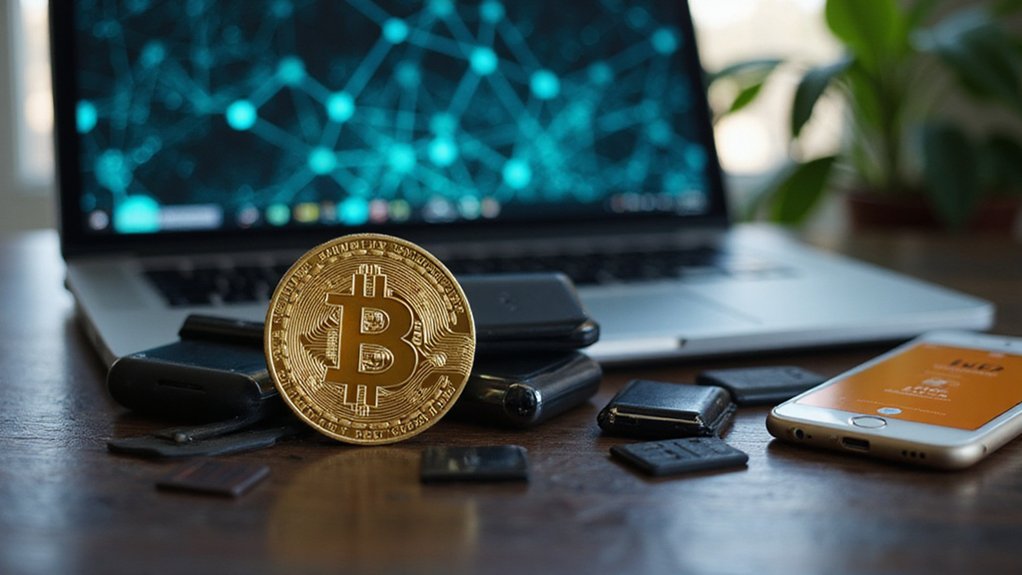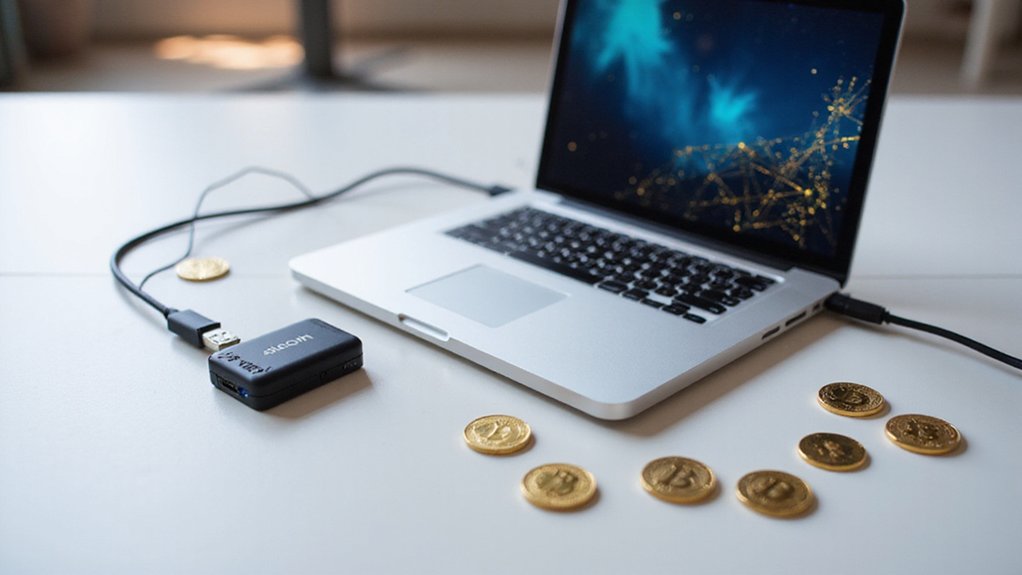Bitcoin newcomers must first secure a digital wallet—essentially a cryptographic key pair that transforms abstract mathematics into monetary reality—before traversing exchanges that demand identity verification despite cryptocurrency’s pseudonymous reputation. The decentralized network operates continuously (unlike traditional banking’s quaint business hours), processing transactions through energy-intensive mining that somehow validates digital scarcity in an infinitely replicable medium. Understanding private key management becomes paramount, since lost keys equal permanently vanished wealth—a feature, not a bug, enthusiasts insist, though such finality might strike newcomers as unnecessarily unforgiving.

While traditional finance operates through centuries-old institutions that close on weekends and charge fees for the privilege of moving one’s own money, Bitcoin presents a rather different proposition: a decentralized digital currency that functions without banks, governments, or anyone asking permission.
This peer-to-peer system, launched in 2009, operates on a blockchain—essentially a public ledger that everyone can verify but no single entity controls.
Understanding Bitcoin’s mechanics requires grasping its fundamental departure from conventional monetary systems. When someone initiates a transaction, they specify the recipient’s wallet address and amount, then digitally sign it with their private key (think of it as an unforgeably complex signature).
Bitcoin transactions bypass traditional banking entirely—each payment carries an unforgeable digital signature that no institution can duplicate or control.
This signed transaction broadcasts across the network, where miners—specialized computers competing to solve cryptographic puzzles—verify its legitimacy through Proof of Work consensus.
The mining process, while energy-intensive enough to power small nations, serves multiple functions: validating transactions, preventing double-spending, and maintaining network security.
Miners receive Bitcoin rewards and transaction fees for their computational efforts, creating economic incentives that sustain this decentralized system without requiring a Federal Reserve equivalent. The network maintains a predictable issuance schedule through automatic difficulty adjustments that occur approximately every two weeks based on total computational power. Bitcoin’s finite supply of 21 million coins fundamentally distinguishes it from traditional currencies that can be printed indefinitely.
For newcomers, acquiring Bitcoin begins with obtaining a wallet—software that generates both a public key (your Bitcoin address) and a private key (your access credential).
The cardinal rule: losing your private key means losing your Bitcoin permanently, with no customer service department to call for recovery.
Wallets range from hardware devices offering maximum security to mobile applications prioritizing convenience.
Purchasing Bitcoin typically occurs through cryptocurrency exchanges, platforms that facilitate trading between fiat currencies and digital assets. This immutable chain structure ensures that once transactions are recorded and confirmed, they cannot be altered or reversed, providing the security and trust that makes Bitcoin viable as digital money.
These exchanges require identity verification (so much for financial anonymity) and charge various fees that would make traditional banks envious.
Alternative acquisition methods include peer-to-peer transactions, earning Bitcoin through services, or mining—though the latter now requires industrial-scale operations.
Bitcoin’s permissionless network operates continuously, processing transactions without holidays or banking hours.
Innovations like the Lightning Network address scalability concerns, enabling faster microtransactions while maintaining the underlying blockchain’s security properties.
For those considering entry into this digital monetary experiment, research remains paramount—understanding both the revolutionary potential and inherent volatility of programmable money.
Frequently Asked Questions
Is Bitcoin Legal in My Country?
Bitcoin’s legal status varies dramatically across jurisdictions—a regulatory patchwork that would make any compliance officer weep.
The United States, Canada, and United Kingdom permit trading and holding, while El Salvador (somewhat ambitiously) declared it legal tender.
China and Saudi Arabia maintain outright bans, presumably preferring their monetary sovereignty intact.
Most European nations allow trading but impose tax obligations, because governments never met a digital asset they couldn’t tax.
How Much Should I Invest in Bitcoin as a Beginner?
Beginners should allocate merely 5-30% of their investment capital to Bitcoin, with risk-averse individuals gravitating toward the lower bound.
Starting with modest amounts ($10-50) allows novices to navigate exchange mechanics and wallet security without catastrophic financial exposure.
The prudent approach involves investing only disposable income—money one can psychologically afford to lose given Bitcoin’s notorious volatility, which has historically demonstrated both euphoric rallies and devastating corrections within compressed timeframes.
What Happens if I Lose My Bitcoin Wallet Password?
Losing a Bitcoin wallet password fundamentally transforms one’s digital fortune into an elaborate digital paperweight.
Unlike traditional accounts with convenient password reset options, Bitcoin wallets operate with unforgiving finality—no customer service representative can magically restore access.
Recovery depends entirely on whether the owner preserved their backup seed phrase (those twelve precious words that constitute crypto’s version of a skeleton key).
Without it, funds become permanently inaccessible, joining Bitcoin’s growing graveyard of lost fortunes.
Can Bitcoin Transactions Be Reversed or Cancelled?
Bitcoin transactions cannot be reversed or cancelled once confirmed on the blockchain—a feature that simultaneously represents the system’s greatest strength and most unforgiving weakness.
Unlike traditional banking’s safety nets, Bitcoin’s immutable ledger treats every confirmed transaction as permanently etched in digital stone.
Users who send funds to incorrect addresses or fall victim to scams discover this harsh reality: there’s no customer service hotline for blockchain regret.
How Do I Pay Taxes on Bitcoin Gains?
Bitcoin gains trigger taxable events upon selling, trading, or purchasing goods—each disposal requiring capital gains calculations.
Taxpayers must determine cost basis (original price plus fees), calculate gains or losses, and distinguish between short-term (ordinary income rates) versus long-term holdings (preferential rates).
Filing involves Form 8949 and Schedule D, with cryptocurrency tax software streamlining complex transaction aggregation.
Maintaining meticulous records proves essential for accurate reporting and potential audit defense.









